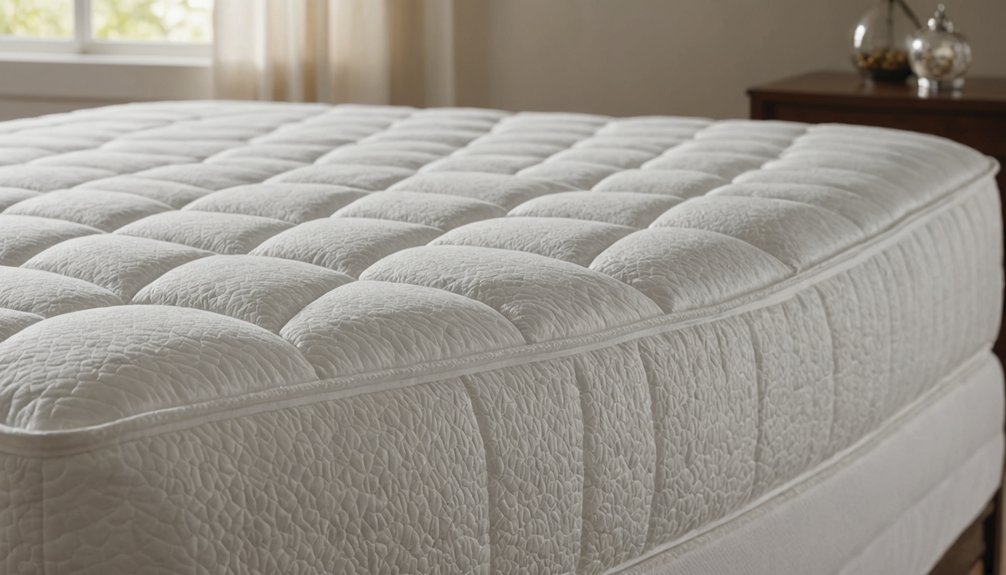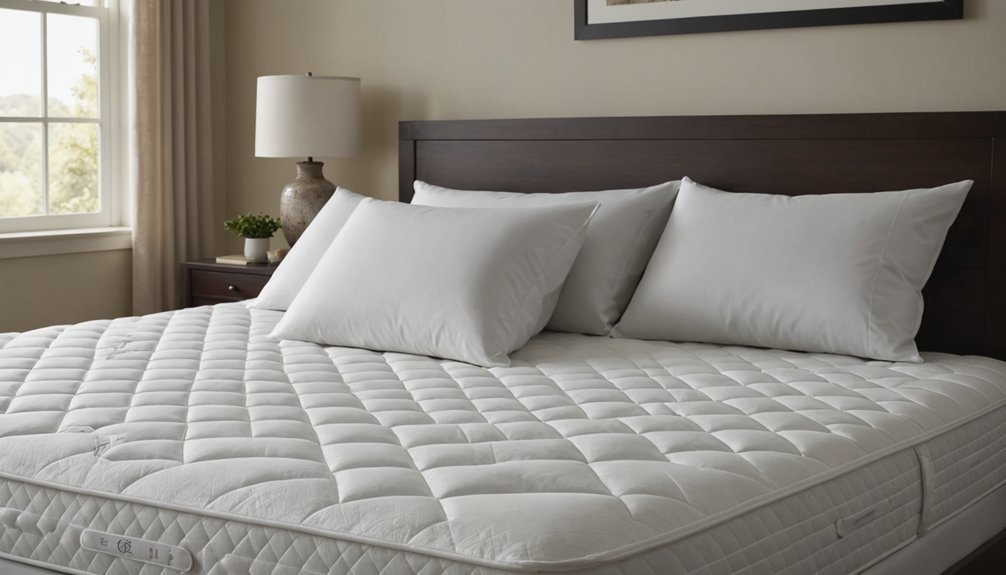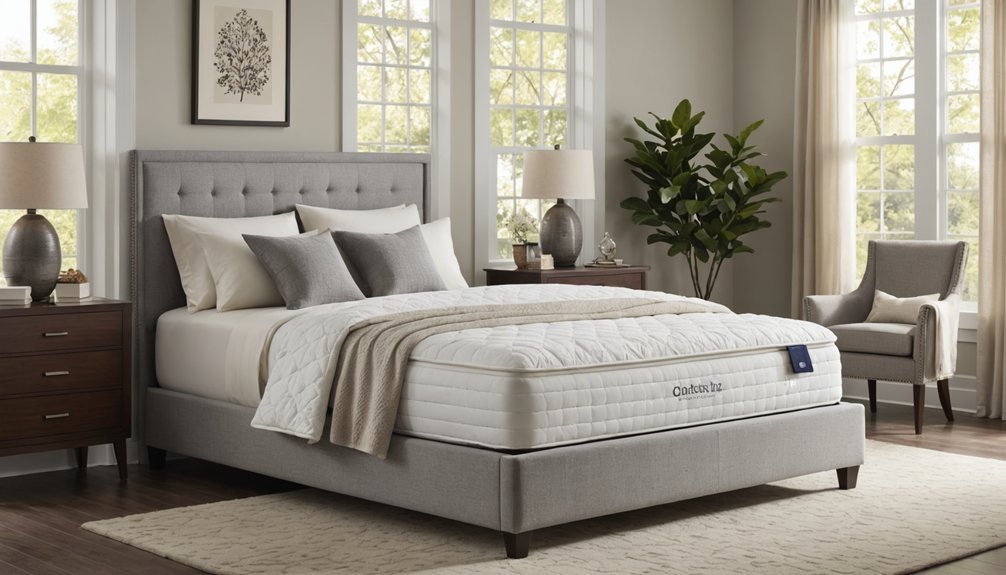Best Mattress Encasements for Bed Bug Protection
If you’re looking to protect your mattress from bed bugs, you’ll need more than just any old cover. The right mattress encasement can mean the difference between peaceful sleep and a full-blown infestation. Today’s options combine advanced materials with smart design features to create an impenetrable barrier against these persistent pests. Before you invest in protection for your bed, discover which encasements truly deliver on their promises.
Key Takeaways
- Utopia Bedding offers reliable protection with a secure zipper-Velcro system and breathable fabric at an affordable price point.
- Look for encasements with tightly woven materials under 0.1 millimeters and lab-tested zipper systems for maximum bed bug protection.
- Bear’s encasement provides premium protection with jersey-knit polyester construction and includes a 10-year warranty.
- Bargoose’s Elite series delivers commercial-grade protection ideal for severe bed bug concerns and high-security requirements.
- Regular inspection and proper installation, including secure zippers and wrinkle-free fitting, are crucial for effective bed bug protection.
Understanding How Mattress Encasements Fight Bed Bugs

While bed bugs can be a nightmare for any homeowner, mattress encasements serve as an essential first line of defense in preventing and controlling infestations.
These specialized covers completely envelop your mattress and box spring, using tightly woven, tear-resistant fabric that bed bugs can’t bite through. They’re designed with secure zippers and locking mechanisms to guarantee no gaps exist where pests could enter or escape.
High-quality mattress encasements use impenetrable fabrics and secure closures to create an escape-proof barrier against bed bug intrusion.
When you use an encasement, you’ll trap any existing bed bugs inside, cutting off their access to food sources. Without blood meals, the trapped bugs will eventually starve. High heat treatments from washing infested bedding can effectively eliminate bed bugs trapped within the encasement.
You’ll also protect your mattress from new infestations since bed bugs can’t penetrate the protective barrier to establish nests or lay eggs. This makes encasements particularly effective, as mattresses typically harbor up to 70% of bed bugs in infested homes.
Top-Rated Mattress Encasements in 2024

Four standout mattress encasements lead the market in 2024, offering superior bed bug protection without sacrificing comfort.
The Utopia Bedding model features a secure zipper-Velcro system and quiet, breathable fabric, while Bear’s encasement comes with a 10-year warranty and jersey-knit polyester construction. The OEKO-TEX certified materials ensure safety and non-toxic protection for users.
Bargoose’s Elite series delivers commercial-grade protection, and Becky Cameron’s microfiber design provides certified protection with easy maintenance.
- Bear’s encasement stands out with its six-sided coverage and extended warranty, making it ideal for long-term protection.
- Bargoose’s commercial-grade materials offer hospital-level security, though initial fabric noise requires breaking in.
- Utopia’s design excels in leak protection while maintaining a thin, unobtrusive profile under your bedding.
Key Features to Look for When Shopping

When shopping for a mattress encasement, you’ll want to focus first on the zipper system, ensuring it’s lab-tested and features secure locks or protective flaps to prevent bed bug entry.
The material should be tightly woven with pores smaller than 0.1 millimeters and include a waterproof polyurethane membrane for complete protection. Regular inspection for stains during sheet changes can help detect any potential bed bug activity early.
You’ll also need to check that the encasement’s size and depth measurements match your mattress exactly, as any gaps or loose fitting areas can compromise its effectiveness.
Zipper and Material Quality
Selecting the right mattress encasement requires careful attention to both zipper and material quality, as these features determine its effectiveness against bed bugs.
You’ll want to look for self-locking zippers with reinforced enclosures and protective flaps that prevent any gaps bed bugs could exploit. The fabric should be tightly woven, tear-resistant, and certified bed bug proof, while still maintaining comfort through breathable materials like cotton terry cloth or polyester blends. Regular machine washing in cold keeps your mattress encasement sanitized and effective.
- Choose encasements with high-quality metal or heavy-duty plastic zippers that will withstand frequent washing and daily use.
- Look for covers that feature patented BugStop seals or similar technology along edges and zipper lines.
- Verify the material combines waterproof protection with breathability through micro-polyester or cotton blends that reduce noise.
Size and Depth Compatibility
Finding the right mattress encasement size and depth is essential for effective bed bug protection. You’ll need to match your encasement to your exact mattress dimensions, as even small gaps can compromise protection.
Before purchasing, measure your mattress‘s length, width, and depth with bedding removed, including any pillow-top or additional layers.
Look for encasements that specifically accommodate your mattress thickness, which can range from standard 6-12 inches to extra-thick varieties exceeding 18 inches. Some manufacturers offer “Plus+ Advantage” encasements that stretch to fit multiple size variants. A quality encasement with reinforced zippers provides the most secure seal against bed bug infestations.
If you have a non-standard mattress size like Full XL, you’ll need to seek specialized options. Remember, the encasement must cover all six sides of your mattress completely, with the zipper closing fully without strain.
Installation and Maintenance Best Practices
To effectively protect your mattress from bed bugs, proper installation and maintenance of your mattress encasement is crucial.
Start by thoroughly cleaning and inspecting your mattress for existing bed bugs, treating it if necessary. When installing, unzip the encasement completely and slide it over your mattress while it’s standing vertically. Confirm the zipper is fully secured with additional closure mechanisms like velcro or sealing tape.
- Check regularly for tears, holes, or zipper damage that could compromise the bed bug barrier
- Clean your encasement using mild detergent on a gentle cycle, and always air dry completely
- Keep the encasement sealed for 12-18 months if you suspect an infestation, and replace it immediately if you find any damage
Price Comparison and Value Analysis
When comparing mattress encasements for bed bug protection, you’ll find prices ranging from $20 to $80, with significant variations in features and quality.
Budget options like Utopia Bedding ($20) offer basic protection but lack warranties, while premium choices like Mattress Safe Sofcover ($57+) include waterproofing and specialized zipper technology.
While budget mattress encasements provide basic bed bug protection, investing in premium options delivers enhanced features and lasting security.
You’ll get better long-term value from mid-range to higher-priced options that come with warranties and certified bed bug testing. Products like Linenspa ($30-$50) strike a balance between affordability and essential features.
If you’re buying multiple encasements, look for bulk discounts to reduce costs. Remember to measure your mattress carefully, as incorrect sizing can’t be returned, and larger sizes naturally cost more.
Consider the encasement’s durability and warranty coverage when evaluating its true cost-effectiveness.
Real Customer Experiences and Reviews
Three key themes emerge consistently in customer reviews of bed bug mattress encasements: protection effectiveness, comfort, and durability.
You’ll find that users particularly value encasements with certified bed bug-proof designs and protective zipper features. Many report satisfaction with products that don’t affect sleep quality or temperature regulation.
- Users consistently praise encasements that maintain protection after multiple washes, especially those backed by long warranties like the Protect-A-Bed AllerZip Smooth’s 10-year guarantee.
- Customers highlight the importance of snug fits and quality zippers, though some note initial installation can be challenging.
- Reviews frequently mention that while premium options cost more, they’re worth the investment compared to expensive bed bug treatments.
The absence of chemical odors and the ability to protect against multiple threats (allergens, dust mites, fluids) are additional benefits customers frequently mention.
Expert Tips for Maximum Protection
You’ll need to carefully install encasements on both your mattress and box spring, ensuring there are absolutely no gaps or tears, especially around zipper areas where bed bugs could potentially escape.
Check your encasements monthly for any damage and immediately repair or replace them if you spot compromised areas.
To maintain maximum protection, combine encasements with regular vacuuming of your bedroom and frequent laundering of all bedding at high temperatures.
Installation Best Practices
Proper installation of a mattress encasement serves as your first line of defense against bed bugs. Before you begin, remove all bedding and stand your mattress vertically. Make sure it’s clean, dry, and free from any existing infestations.
Unzip the encasement completely and scrunch it like a sock for easier application. Pull it down evenly from top to bottom while keeping the zipper aligned for proper closure.
- Secure the zipper fully and attach any manufacturer-provided seals or locks to prevent pest entry or escape.
- Check for bunching, wrinkles, or gaps that could compromise protection, especially around corners and seams.
- Position the breathable side up if specified, and regularly inspect the encasement for damage or wear that might reduce effectiveness.
Ongoing Maintenance Requirements
To maximize the protective benefits of your mattress encasement, consistent maintenance and monitoring are essential. You’ll need to regularly inspect for damage, maintain proper cleaning protocols, and ascertain long-term effectiveness of your bed bug barrier.
| Maintenance Task | Frequency |
|---|---|
| Visual Inspection | Weekly |
| Surface Cleaning | Monthly |
| Zipper Check | Weekly |
| Vacuum Treatment | Bi-weekly |
Remember to wipe down your encasement with mild soap and water, avoiding harsh chemicals that could compromise the fabric. Don’t machine wash unless specifically permitted by the manufacturer. Keep the encasement in place for at least 12-18 months after treatment to ascertain all bed bugs die naturally. Use bed leg interceptors as an additional monitoring tool, and check them regularly for any signs of activity. Replace your encasement immediately if you notice tears, holes, or loose stitching.
Conclusion
You’ll find investing in a quality mattress encasement is essential for effective bed bug protection. Choose options with secure zippers, waterproof membranes, and durable materials like those from Utopia Bedding or Bear. Don’t forget to properly install and maintain your encasement for maximum effectiveness. With the right product and care, you’re not just preventing bed bugs – you’re protecting your overall sleep environment.

